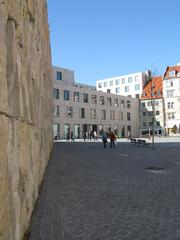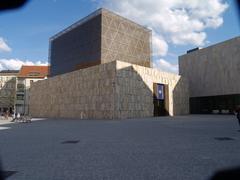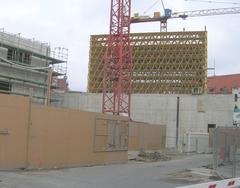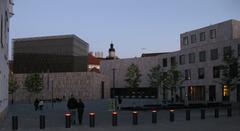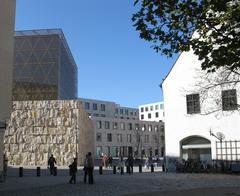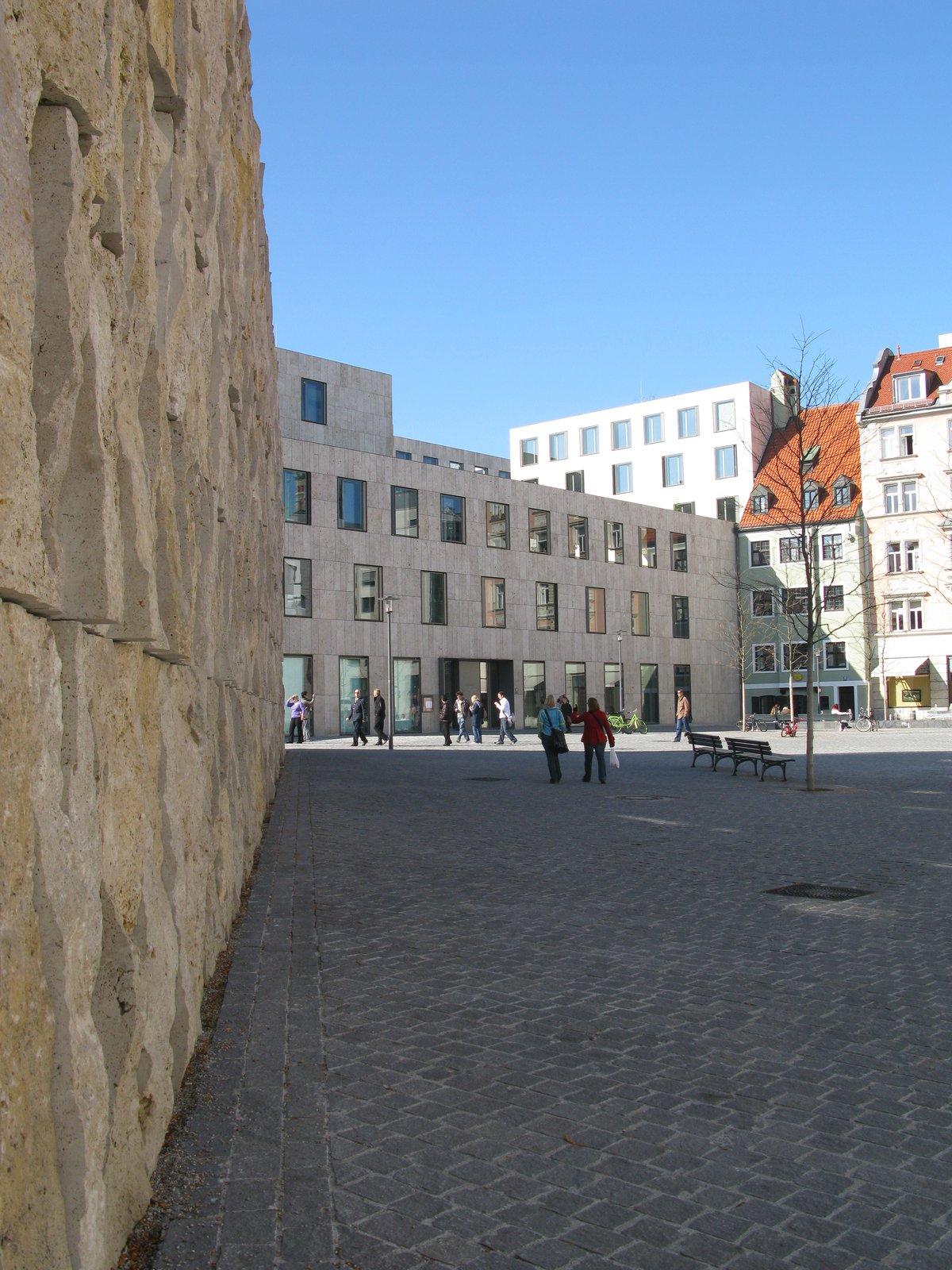
Ohel Jakob Synagogue Munich: Visiting Hours, Tickets, and Historical Significance
Date: 14/06/2025
Introduction
The Ohel Jakob Synagogue, located at Sankt-Jakobs-Platz in Munich’s Old Town, is a profound symbol of Jewish resilience, renewal, and ongoing cultural life in one of Germany’s most historically significant cities. As both an active Orthodox place of worship and a central feature of Munich’s Jewish Center, the synagogue stands as a living memorial to the city’s Jewish community—past and present. Its name, “Ohel Jakob” (“Jacob’s Tent” in Hebrew), is reflected in the building’s remarkable design, combining a robust travertine stone base with a luminous glass cube adorned with interlocking Stars of David. Inaugurated on November 9, 2006—the anniversary of Kristallnacht—the synagogue is both a place of remembrance and hope, located near the site of the original 19th-century synagogue destroyed by the Nazis in 1938 (muenchenwiki.de, munich.travel, muenchen.de).
This guide offers comprehensive information for visiting Ohel Jakob Synagogue, including its historical context, architectural highlights, visiting hours, ticketing procedures, accessibility, travel tips, and nearby attractions. Whether you are interested in Jewish heritage, modern architecture, or cultural remembrance, this article will help you plan a meaningful and respectful visit (jguideeurope.org, ikg-m.de).
Historical Background
Origins and Early Community
Jewish life in Munich dates back to the 13th century, enduring cycles of growth, expulsion, and return. By the late 19th century, the community flourished and built the original Ohel Jakob Synagogue at Herzog-Max-Straße No. 7, near Stachus. Designed by Albert Schmidt and completed in 1887, it was a monumental expression of Jewish integration and prominence in Munich (muenchenwiki.de).
Nazi Era and Destruction
With the rise of National Socialism, Munich’s Jewish community suffered tragic losses. In June 1938—months before Kristallnacht—the original synagogue was ordered demolished by the Nazi regime (muenchen.de). The location is now marked with a memorial stone, serving as a somber testament to Munich’s lost Jewish heritage (ikg-m.de).
Post-War Rebirth
After World War II, survivors rebuilt community life, reopening the Reichenbachstrasse Synagogue in 1947 (jewish-heritage-europe.eu). However, this synagogue was not a visible public symbol. In the late 20th century, plans emerged for a new synagogue in the city’s heart.
Construction of the New Synagogue
The foundation stone for the new Ohel Jakob Synagogue was laid on November 9, 2003. The building, designed by Rena Wandel-Hoefer and Wolfgang Lorch, was inaugurated in 2006, emphasizing remembrance and renewal (ikg-m.de). The architecture features:
- Travertine Stone Base: Evoking Jerusalem’s Western Wall (destination-munich.com).
- Glass Cube: A 28-meter-high luminous structure with interlocking Stars of David, sheathed in bronze-colored mesh (muenchenwiki.de).
- Main Portal: Six meters high, adorned with Hebrew letters symbolizing the Ten Commandments (muenchen.de).
The synagogue is part of a complex with the Jewish Museum Munich and community facilities, symbolizing the revival of Jewish life at Munich’s core.
Architectural Highlights
Symbolism and Structure
The Ohel Jakob Synagogue’s architecture is deeply symbolic. The travertine base represents rootedness and tradition, while the glass cube evokes the biblical tent, openness, and renewal (munich.travel). Interlaced Stars of David in the bronze mesh reinforce Jewish identity. The main entrance, with Hebrew letters for the Ten Commandments, imparts spiritual gravitas (wikipedia).
Interior and Spiritual Atmosphere
Inside, the sanctuary features warm Lebanese cedar wood and Jerusalem stone, with golden psalms inscribed on the panels. The bimah and aron kodesh face Jerusalem, and natural light creates an uplifting ambiance (muenchen.de, ikg-m.de).
The “Gang der Erinnerung” (Corridor of Remembrance)
A central memorial feature is the 32-meter underground corridor linking the synagogue and Jewish Center, with illuminated glass panels listing over 4,500 names of Munich Jews deported and murdered during the Holocaust (dw.com). This passage serves as a moving tribute and reminder.
Integration with Jewish Center
The synagogue anchors a vibrant center that includes the Jewish Museum Munich, educational institutions, a kosher restaurant, and community facilities. This complex fosters educational programs, cultural events, and interfaith dialogue (jguideeurope.org).
Religious Life and Community
Ohel Jakob Synagogue serves approximately 9,300 community members, making it the second largest in Germany (BBC News). The sanctuary accommodates over 550 worshippers, with daily, Shabbat, and festival services, and a smaller prayer room for weekday minyanim (ikg-m.de). The site is not only a place of worship but also the heart of Jewish cultural life, hosting concerts, lectures, and public events to foster understanding and tolerance.
Visiting Information
Location and Getting There
- Address: Sankt-Jakobs-Platz 18, 80331 Munich, Germany (en.munich.foravisit.com)
- Public Transport:
- U-Bahn: Sendlinger Tor and Marienplatz stations are nearby.
- Tram: Tram Line 19 stops at Sendlinger Tor.
- On Foot: 5–10 minutes from Marienplatz.
Opening Hours
- Guided Tours: Tuesday to Sunday, 10:00 AM – 5:00 PM. Closed Mondays and Jewish holidays (ikg-m.de).
- Public Entry: Only possible via scheduled guided tours due to security protocols.
Tickets and Guided Tours
- Standard Entry Fee: €8; free for students, schoolchildren, and Munich Pass holders.
- Booking: Advance reservation required via email ([email protected]) or phone (+49 (0)89 202 400 491).
- Tours: Offered in German, English, French, Italian, Russian, and Hebrew. Tours last 60–90 minutes and include history, architecture, and ritual explanations (ikg-m.de).
Accessibility
- Fully wheelchair accessible, including the “Gang der Erinnerung.” Notify staff of special needs in advance (ikg-m.de).
Security and Visitor Protocol
- Arrive early for security checks. Valid photo ID required; large bags discouraged.
- Dress modestly; men may be asked to wear a kippah (provided onsite).
- Photography is generally not permitted inside the synagogue.
Visitor Facilities
- Kosher restaurant, nursery, school, restrooms, and cloakroom available.
- The synagogue is surrounded by cafes, shops, and cultural institutions.
Nearby Attractions
- Jewish Museum Munich: Explores local Jewish history and culture (Jewish Museum Munich).
- Viktualienmarkt: Open-air market for local foods.
- Marienplatz: Munich’s central square.
- Sendlinger Tor: Historic city gate and transport hub.
Events and Cultural Programming
The Jewish Center hosts lectures, concerts, and public events throughout the year. For an updated calendar, visit the IKG Munich website.
Practical Visitor Tips
- Book in advance, especially during peak seasons.
- Specify language preference for tours.
- Allow time for security checks.
- Respect site protocols and customs.
Frequently Asked Questions (FAQ)
Q: What are the visiting hours?
A: Guided tours run Tuesday to Sunday, 10:00 AM to 5:00 PM; closed Mondays and Jewish holidays. Advance booking required.
Q: How do I book tickets?
A: Reserve by email ([email protected]) or phone (+49 (0)89 202 400 491).
Q: Is the site wheelchair accessible?
A: Yes, including the memorial corridor.
Q: Are guided tours available in multiple languages?
A: Yes—English, French, Italian, Russian, and Hebrew, in addition to German.
Q: Can I take photos inside?
A: Photography is not permitted inside due to security and religious reasons.
Visitor Experience Highlights
Visitors praise the synagogue’s striking architecture, spiritual atmosphere, and the moving “Gang der Erinnerung.” The combination of modern design, rich history, and vibrant community life makes it a unique destination for those interested in architecture, history, and intercultural dialogue (evendo.com).
Summary and Recommendations
The Ohel Jakob Synagogue is a powerful symbol of Munich’s Jewish heritage, blending tradition and innovation. From its 19th-century origins and wartime destruction to its 21st-century rebirth, the synagogue stands as both a living memorial and a beacon of hope. With guided tours, accessibility, and proximity to other key sites, it offers a rewarding and educational experience for all visitors. Plan ahead, book your tour, respect the site’s customs, and consider exploring the wider Jewish Center complex for a comprehensive cultural journey (muenchen.de, dw.com, ikg-m.de, munich.travel).
Call to Action
References and Further Reading
- Ohel Jakob Synagogue Munich: History, Visiting Hours, Tickets & Travel Guide, MunichWiki
- Visiting the Ohel Jakob Synagogue in Munich: History, Significance, and Visitor Information, Munich Tourism
- Ohel Jakob Synagogue Munich: Visiting Hours, Tickets, and Architectural Highlights, Synagogues360 & GKD Project
- Ohel Jakob Synagogue Visiting Hours, Tickets, and Cultural Guide in Munich, En Munich for a Visit
- Memorial and Educational Features of Ohel Jakob Synagogue, Munich Official Site
- Jewish Museum Munich, Official Website
- What the Munich Synagogue Destroyed by the Nazis Symbolized, DW News
- Ohel Jakob Synagogue Munich Today, Jewish Community Munich
- Guided Tours and Visitor Information, IKG Munich
- Jewish Cultural Programming and Community Life, JGuide Europe
